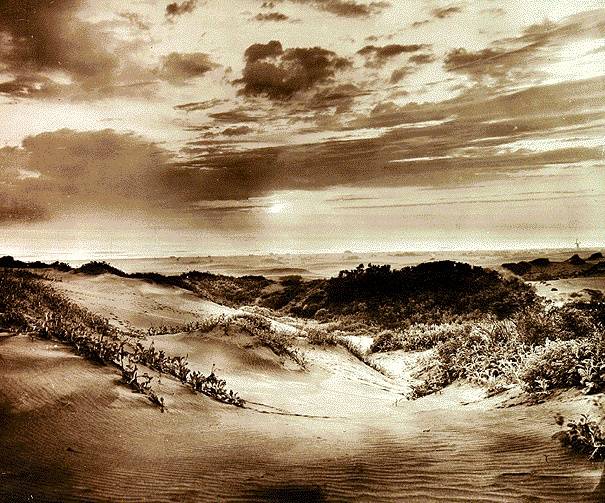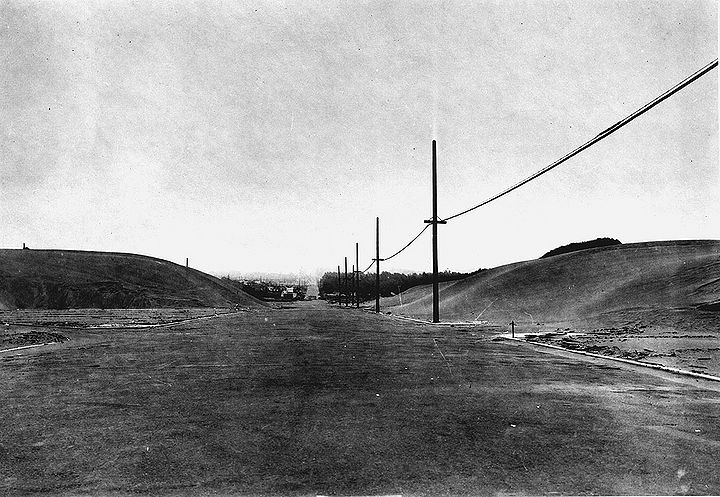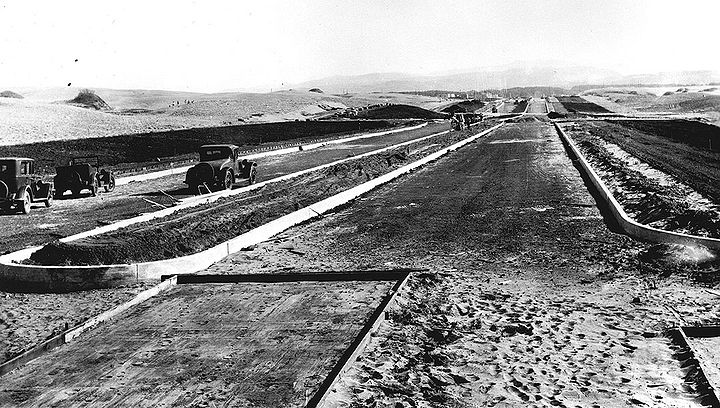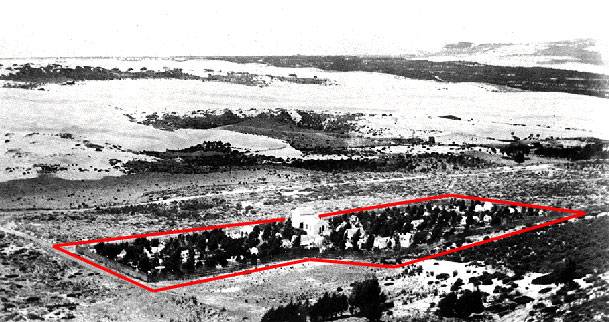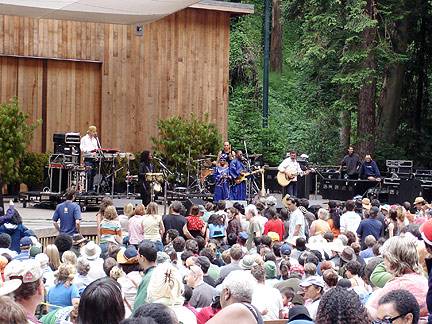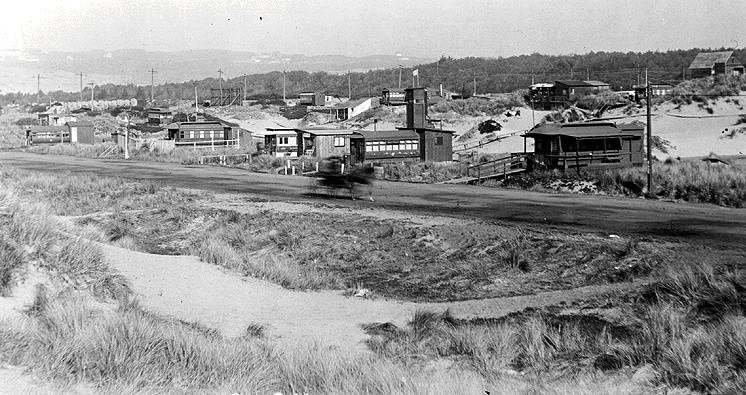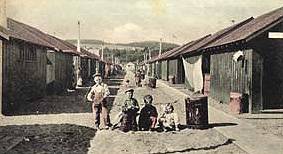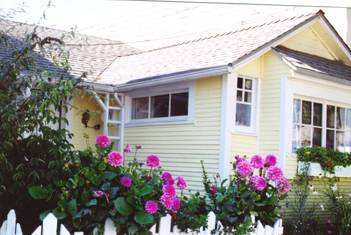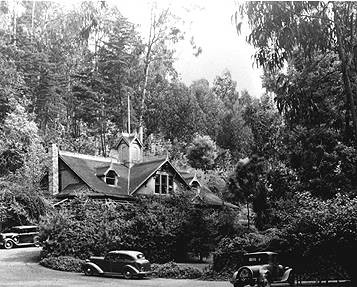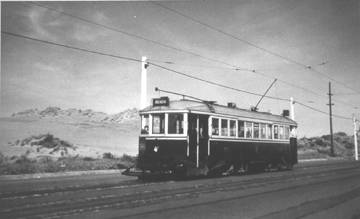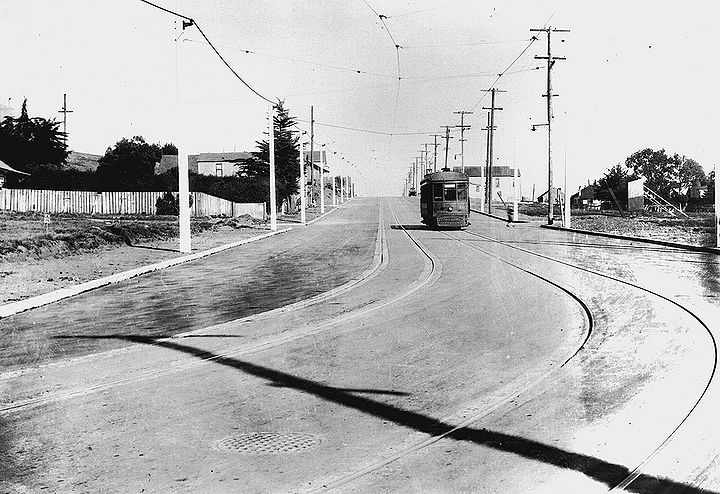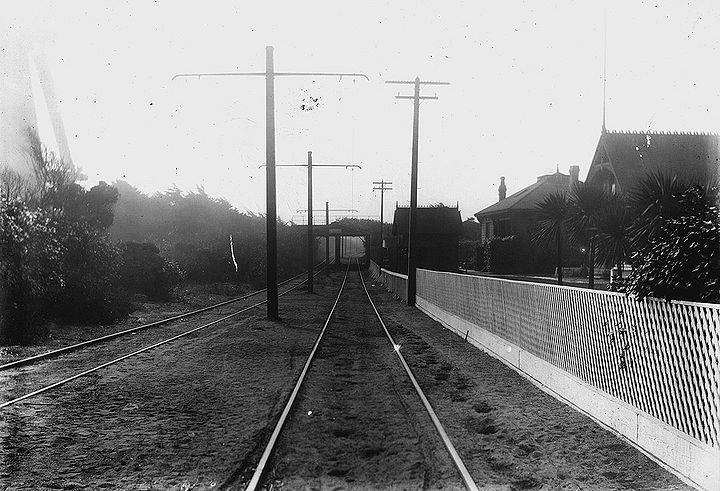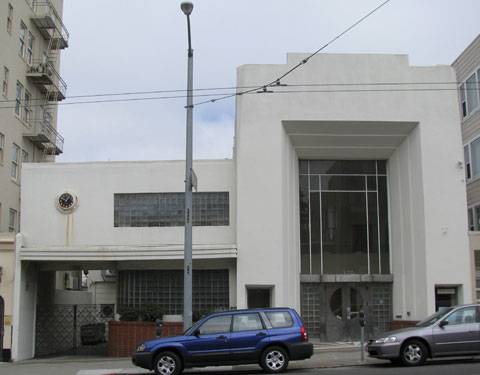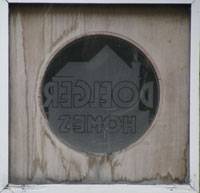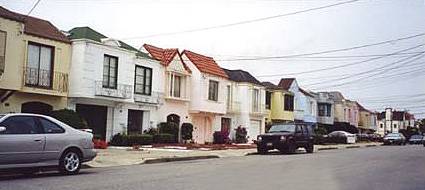The Sunset District: From Dunes to Cityscape
Historical Essay
by Lorri Ungaretti
Sunset dunes, c. 1900 (at upper right is Golden Gate Park windmill).
Photo: Private Collection
A street plowed and paved through the sand dunes, c. 1920s.
Photo: Charles Ruiz collection
The Changing Physical Landscape of the Sunset District:
The Late 1800s through the Mid-1900s
San Francisco's "Sunset District" is bordered on the north by Lincoln Way, on the west by the Great Highway, on the south by Sloat Boulevard, and on the east by a vague boundary going south from Arguello, Golden Gate Heights, the hill above Kezar Stadium, Golden Gate Heights, and 15th Avenue. It includes neighborhoods such as Edgewood-Belmont, the Inner Sunset, and Parkside.
The district underwent major change in a short time. In early 1900s most of it was windswept sand dunes. By the mid-1900s, almost all had been developed.
Like all of California, the area was a Mexican possession until the Treaty of Guadalupe Hidalgo in February of 1848 ceded it to the United States. Called "The Outside Lands," the area was U.S. government land at the time of the Gold Rush. With few roads and no public transportation, the area was considered inaccessible and uninhabitable. Nevertheless, the City and Country of San Francisco, which was growing rapidly, desired the land and petitioned for it in the 1850s. After years of court battles the U.S. Government declared the area part of San Francisco in 1866. Speculators quickly began purchasing land.
The origin of the "Sunset" name is not entirely clear. Some historians claim that Aurelius Buckingham, a developer who owned property in the Sunset, coined the term in 1886. Others say that the area got its name from the California Midwinter Fair, which was held in Golden Gate Park in 1894 and was also known as "The Sunset City."
Another story, by local researcher Angus MacFarlane, credits a neighborhood organization, which, in August 1895, met at 9th Avenue and H Street and chose the name, "Sunset District Improvement Club," in recognition of the magnificent sunset the group had just witnessed outside the hall.
Major Street Name Changes
Sunset streets running east to west were originally named for the letters of the alphabet, starting in the Richmond District with A (later Anza) Street and ending with the Sunset's X (later changed to Yorba-for Y) Street. The city changed the street names in late 1909, choosing names that kept the alphabetical order of the streets, e.g. Pacheco, Quintara, Rivera, etc. Two exceptions were Fulton (previously D) Street and Lincoln Way (previously H Street).
Two other street names were changed in the twentieth century: First Avenue was changed to Arguello Boulevard, and Thirteenth Avenue was changed to Funston.
Sunset Boulevard under construction looking south at Kirkham, April 2, 1931.
Photo: SFDPW, courtesy Charles Ruiz collection
Carl Larsen
The Larsen Chicken Ranch on 16th-17th Avenues between M and N Streets. Taken approximately 1898.
Photo: Private Collection, San Francisco
One of the earliest settlers in the Sunset was Carl Larsen, who came to San Francisco from Denmark in 1869. He owned a downtown business, the Tivoli Café, on Eddy Street. In 1888, he began buying large amounts of land in the dunes of the Sunset. Larsen's Chicken Ranch ran from 16th to 17th Avenues, from M Street to N Street. Each morning, a horse-drawn carriage took eggs from the Larsen Chicken Ranch to the Tivoli Café, probably along the only through road in the Sunset, the Central Ocean Road.
Carl Larsen never married and he was generous to his adopted city. In 1924, he donated land at the eastern edge of the Sunset, land now known as Golden Gate Heights Park and Larsen's Peak. In 1926, Larsen donated two full blocks from 19th to 20th Avenues, between Ulloa and Wawona. Many Sunset children grew up with memories of playing at Larsen Park, best remembered for the military airplane that children could climb over endlessly and for Larsen Pool (now Charlie Sava pool, named after a beloved swimming instructor and coach of Olympic swimmer Anne Curtis).
Sigmund Stern Grove and Pine Lake Park
George Greene came to San Francisco from Maine in 1847 and quickly homesteaded land, starting at Nineteenth Avenue and Sloat Boulevard and going west almost to the beach. He planted and built on land that few people at that time had seen or wished to own. However, the land slowly became desirable and, in 1887, the Greene family was forced by a lawsuit to give up most of the land. The Greenes were allowed to keep only the blocks between Wawona and Sloat, from Nineteenth to about Twenty-fifth Avenues.
In 1892, George Greene Jr. built the Trocadero Inn, a Victorian-style roadhouse he ran for more than 20 years. (See "A Few Historical Buildings" below.)
In 1931, Rosalie Stern, widow of civic leader Sigmund Stern, was looking for a park to purchase and donate to the city in honor of her deceased husband, civic leader Sigmund Stern. Her friend, Golden Gate Park Superintendent John McLaren, recommended the land at Nineteenth and Sloat. The Greenes sold their property, including the Trocadero, to Stern.
Sigmund Stern Grove opened to the public on June 4, 1932. At the time, a San Francisco newspaper reporter wrote, "Thousands of San Franciscans do not even suspect the existence of the lovely redwood and eucalyptus that once was part of the old Trocadero ranch. It is way over by Sloat Boulevard, a beautiful amphitheater of hillside, trees, and greensward."
Stern Grove still hosts free music concerts on Sundays during the summer, here Amadou & Mariam playing in 2007.
Photo: Chris Carlsson
Over the following five years, the city purchased land west of the original grove, including Pine Lake (also known as "Mud Lake"), enlarging Sigmund Stern Grove. Each year since 1938, the grove has hosted free summer music concerts.
Carville-by-the-Sea
Carville was a community of homes made up of discarded horse-drawn streetcars
Photo: Private Collection, San Francisco, CA
At the end of the 19th century, the city began replacing horse-drawn cars with electric streetcars. Dumped out near the beach in the Sunset, many cars were sold to individuals who paid $10 if the car had no seats and $20 if it did. People set up these cars along the sand at the Great Highway and turned them into homes. Some stacked two or three cars on top of one another for a multi-story home; others placed cars in a u-shape to create a courtyard protected from the wind.
The area became known as "Carville-by-the-Sea" or simply "Carville." By 1901, 50 families lived in this unusual community that included a two-story church and a café. By the 1930s and 1940s, as development increased and property became more valuable, these cars disappeared. Today, two surviving houses are known to be built around streetcars. Others may exist as well.
Earthquake Shacks
An earthquake shack encampment in the Richmond District
Photo: John Freeman
After the earthquake and fire of 1906, approximately two-thirds of the population of San Francisco was left homeless. In a remarkable project financed primarily by donations to a relief fund, 5,610 tiny cottages were built to house the homeless. These cottages, now called "earthquake shacks," were placed in rows in parks around the city. Rent ranged from $1 to $2 per month.
By the end of 1906, the city began encouraging people to find vacant lots and remove the shacks from public land. In fact, the city agreed to refund all rents paid by people who had their shacks removed by a certain date. Some people moved their shacks to the Sunset, where plenty of lots were available.
This house on 24th Avenue is made up of several 1906 earthquake shacks.
Photo: Lorri Ungaretti
Because the shacks were so small (typically 14 by 18 feet), many people cobbled together three or four shacks to make a home. In 1982, Sunset renter Jane Cryan discovered that she was living in a house composed of three earthquake shacks. She conducted extensive research and founded the Society for the Preservation and Appreciation of San Francisco Refugee Shacks (no longer in existence). In 1984, she convinced San Francisco to name the house at 1224 - 24th Avenue a city landmark.
Another group of four earthquake shacks was discovered in the Sunset District a few years ago on Kirkham Street near 47th Avenue. The Western Neighborhoods Project is working to preserve these shacks and make them available for public viewing.
A Few Historical Buildings
Currently six Sunset buildings are city Historic Landmarks:
1. 1348 - 10th Avenue. This firehouse, built in 1898, became city landmark #29 in 1970. 2. 1651 - 19th Avenue. The original Shriner's Hospital, built in 1922-23, became city landmark #221 in 1998. 3. 1227 - 24th Avenue. A small home made up of several earthquake shacks built in 1906 became landmark #171 in 1984. 4. The Sunset Branch Library at 18th and Irving was named a landmark in June 2004. 5. 1201 Ortega Street. The original building of the Infant Shelter at 19th and Ortega became city landmark #242. 6. The Doggie Diner head on Sloat Blvd. at 45th Ave became city landmark #254.
Originally opened in 1929 as an orphanage, The Infant Shelter housed the San Francisco Conservatory of Music since 1956. The music school moved downtown in 2005, and the building then became the home of a French school which promised to not destroy any of the buildings.
The Trocadero Inn
Photo: Private Collection, San Francisco, CA
One of the most famous Victorian buildings in the Sunset is the Trocadero. It was built in 1892 by George M. Greene. He ran it as a roadhouse until Prohibition when he said "I did not want a bootlegger situation there." In the 1930s, architect Bernard Maybeck (best known for the Palace of Fine Arts) oversaw the restoration of the Trocadero. The building still stands and is rented out to the public for parties.
Transportation
Building in the Sunset began primarily in the eastern section, which was more accessible from the city center, and the outer Sunset, which people could reach from the south (and also provided "beachfront homes.") The Central Ocean Toll Road appears on early maps. It cut through the Sunset, starting south of Sloat at about 36th Avenue and zigzagging north through the Sunset between 17th and 18th Avenues from R Street to K Street, then east toward downtown. It ran behind Larsen's Chicken Ranch and most likely was the route taken to bring eggs to the Tivoli Café.
The L Taraval line ran through the sand dunes in the 1940s
Photo: Jack Tillmany
As streets were cut through, more people moved to the Sunset. However, public transportation played the biggest role in the landscape change. In 1883, Leland Stanford began running a steam train along H Street (now Lincoln Way) from Stanyan Street to the beach. In 1898, the line changed to electric train cars and then later to streetcars. The Twin Peaks Tunnel opened in 1917 and the L car brought service to the Parkside area of the Sunset in 1919. The L originally went only as far as Fifteenth Avenue, but by the 1920s, it traveled almost to the beach along Taraval Street. The Sunset Tunnel, connecting Cole Valley to Duboce Street, opened in 1928, with Mayor "Sunny Jim" Rolph driving the first N Judah streetcar. With this line, more people could live in the Sunset and get to downtown jobs.
M-Streetcar running in western San Francisco, no date.
Photo: Charles Ruiz collection
Train tracks in backyard near West Portal/Ocean Avenue, no date.
Photo: Charles Ruiz collection
Developers
Many developers and architects built houses in the Sunset in the 1920s and 1930s. Some built entire blocks of houses, while others designed random homes for individuals or built a few homes on different blocks. Some remembered names are Louis Epp, Ray Galli, and Oliver Rousseau.
Rousseau was a trained architect who got his start in the Sunset, building better-than-average homes, primarily in the central Sunset in the 1500 blocks between 34th and 41st Avenues. He also built a few homes scattered in areas like the Parkside. His houses often featured "extras," such as sunken living rooms, hand-painted designs on kitchen walls, and outside turrets. He and his brother went on to form the Rousseau Brothers and became known for fine houses built in other San Francisco neighborhoods and later in Richmond, Hayward, and Sacramento.
Doelger homes were sold out of this art deco office building at 320 Judah Street
Photo: LisaRuth Elliott
The window - which faces inward - still exists on the building long after the Doelger dynasty.
Photo: LisaRuth Elliott
The best-known developer of houses in the Sunset District was Henry Doelger. Doelger grew up in the Inner Sunset at the corner of 7th Avenue and Hugo Street. He and his brother Frank, formed the Doelger Brothers and began building homes in the 1920s. However, it was after Frank's untimely death in 1932 that Henry became a prolific builder.
The Doelgers built their first homes, about 25 of them, on 39th Avenue in 1926, their first year in business. However, Henry Doelger is best known for the houses he built in a large concentrated area, approximately from 27th to 39th Avenues between Kirkham and Ortega Streets. This area was sometimes called "Doelger City." People accustomed to the details of Victorian and Edwardian buildings scoffed at the "cookie-cutter" way these houses were built, but the houses were well built and have stood the test of time. At one point, Henry Doelger completed two houses a day.
Henry Doelger homes had a basic floor plan but differed slightly on the outside.
Photo: Lorri Ungaretti
Most of these houses have a similar floor plan-two bedrooms and one bathroom, with living quarters upstairs from a street-level garage. (Doelger is sometimes credited with inventing this floor plan, but it existed before he began building as a solution to building on a small lot.) The Doelger homes made home ownership possible to families who in the past could only dream of owning their homes.
Not all of Henry Doelger's Sunset homes were the "low-end" buildings for families. He built more expensive, larger homes in Golden Gate Heights including his own house at 1995 - 15th Avenue, and a house for William Saroyan's family at 1821 - 15th Avenue.
Conclusion
By the 1960s, almost all the land in the Sunset was covered with homes, churches, schools, businesses, and a few parks. In the 1970s, development eliminated the last major sand dune when St. Ignatius College Preparatory was built at 2001 - 37th Avenue.
In the late 1800s, at most only a few hundred people lived in the Sunset. By 1930, about 35,000 residents were in the area and by 1940 48,000 people called it home. Now, approximately 100,000 people live in the Sunset. This area changed quickly - in just 50 years from "uninhabitable" sand dunes to completely developed small neighborhoods.
© 2004

